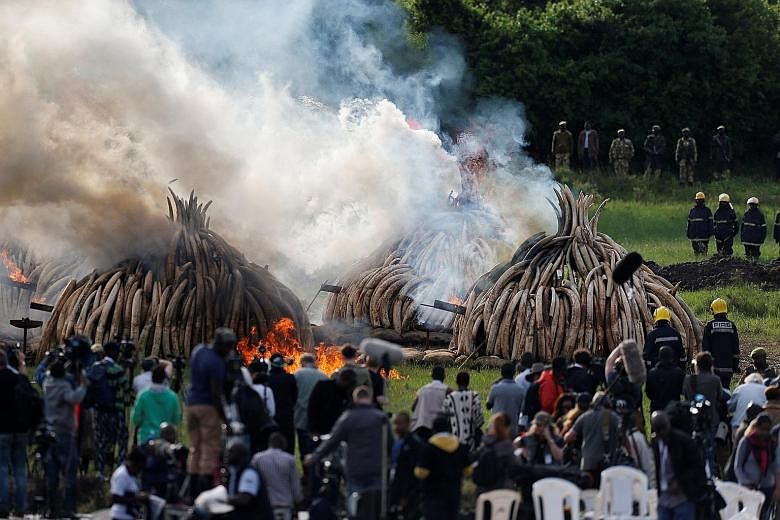NAIROBI • Eleven giant pyres of tusks were set on fire yesterday as Kenya torched its vast ivory stockpile in a grand gesture aimed at shocking the world into stopping the slaughter of elephants.
Kenyan President Uhuru Kenyatta lit the semicircle of tusks, expected to burn for days in Nairobi's national park. He has demanded a total ban on trade in ivory to end trafficking and prevent the extinction of elephants in the wild.
"The height of the pile of ivory before marks the strength of our resolve," Mr Kenyatta said, before setting fire to the pyres.
He added: "No one, and I repeat no one, has any business in trading in ivory, for this trade means the death of our elephants and the death of our natural heritage."
Gabon President Ali Bongo Ondimba, who lit one of the pyres, spoke of the "massacre" of forest elephants in central Africa, and said he backed moves to end all sale of ivory.The bonfires will be the largest torching of ivory, involving 105 tonnes from thousands of dead elephants, dwarfing by seven times any stockpile burned before.
Another 1.35 tonnes of rhino horn will also be burned, representing the killing of some 340 of the endangered animals.
Africa is home to between 450,000 and 500,000 elephants, but more than 30,000 are killed every year on the continent to satisfy demand for ivory in Asia, where raw tusks sell for around US$1,000 (S$1,350) a kilogram.
The pyres prepared in Nairobi contained some 16,000 tusks and pieces of ivory.
On the black market, such a quantity of ivory could sell for over US$100 million (S$135 million), and the rhino horn could raise as much as US$80 million. Rhino horn can fetch as much as US$60,000 per kilogram, more than gold or cocaine.
But despite the staggering size of the pyres set on fire, totalling some 5 per cent of global stocks, the ivory represents just a fraction of the animals killed every year.
The ivory seized from poachers and smugglers over several years, and from animals which died naturally, is equivalent to just a quarter of the number of elephants massacred every year to feed demand in Asia, where an elephant's tooth is seen as a status symbol.
Ivory itself does not burn, so the fire was fuelled by a mix of thousands of litres of diesel and kerosene injected through steel pipes buried in the ground leading into the heart of the tusk pyramids.
Meanwhile, at least 17 people were killed in Nairobi last Friday in flood-related incidents caused by torrential rains, including the collapse of a residential building on the outskirts of Kenya's capital, police said.
At least 10 people were killed when the six-storey building in Huruma disintegrated, police spokesman Charles Owino said.
Yesterday, rescue workers racedto save residents from the rubble, including a mother and a baby whose cries could be heard.
Mr Kenyatta visited the site and ordered the arrest of the owners.
The building had 198 rooms.
Some residents escaped before the collapse and at least 133 people had been rescued.
AGENCE FRANCE-PRESSE, BLOOMBERG, REUTERS

